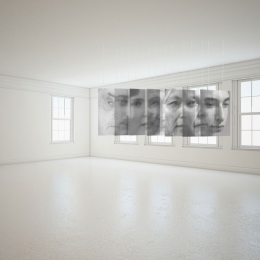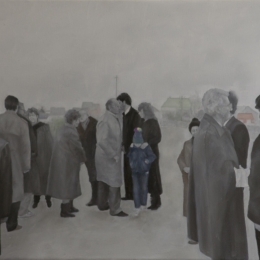art or business
Ties
Marianne Csáky | Bazil Duliskovich | Sári Ember | Péter Trembeczki | Éva Magyarósi | Eszter Galambos | Eszter Herczeg | Olívia Kovács | Gábor Arion Kudász | Judit Flóra Schuller | Ágnes Verebics
Surely everyone has already raised the question whether human existence really only begins with birth?
Whether besides the physical and genetic connection with the family members there are additional ties as well?
Whether our the present situations, our actual problems are rooted only in our own lives, or it is possible that they originate elsewhere?
What impressions can our ancestors and family members leave in us?
Can it be that through these inherited imprints we influence our present environment?
We are not only able to remember consciously. And we are not only able to remember with our mind. Our genes also keep memories. Genetic studies revealed that the operation of genes change due to environmental effects, and this change is inherited - in other words: the genes remember. So is it possible that outside influences, or acquired properties are able to change the hereditary structure of the body. Many researchers believe that these so-called epigenetic processes may explain the increased susceptibility for some diseases (for example allergy) within a family.
But in addition to the biological explanation, there is a more elusive one. Rupert Sheldrake, English biologist, in his morphogenetic field theory concluded that there are invisible energy fields connected to each other, which have an effect on both our physical and mental being. These fields carry and transmit information through space and time -remember - causing a recurrence of specific events. So it happens that the experiences of ancestors, their life events can affect the lives of future generations by their (intentionally or unintentionally) created patterns and models. According to Sheldrake each morphic system is linked to a multitude of fields, dating back to the collective memory of the species - the Jungian collective unconscious - serving as archetypal precedents of forms and patterns of behaviour.
On The First International Conference on Family Constellations, Sheldrake and the founder of system- psychotherapy, Bert Hellinger, found out that Sheldrake’s morphogenetic field is the same as Hellinger’s intellectual field used for family constellations. According to Hellinger the individual's fate is inextricably linked to the fate of the members of the family, so much so that the individual may feel a strong unconscious desire to imitate the experiences and behaviours of the ancestors. This unconscious desire to connect can be so strong – according to the trans-generational phantom theory developed by Miklós Ábrahám and Mária Török in the 1970-80s - that some people inheriting their predecessors’ spiritual content, live in a collective psychological life incorporating multiple generations, and full of memory traces. Research on trans-generational trauma (such as the Holocaust) raised the question of the existence of collective world of experience that, shining through to the next generation, is deeply engraved in the subject's unconscious.
The unconscious does not know historical time. The analysis of current problems often opens the door to the history of previous generations, to suppressed traumas as well. In the joint family soul that goes back to generations there are laws and roles, which if damaged, can affect the members of the family for decades, even centuries. All that our parents, our grandparents lived through, experienced, we have in ourselves, even if we are not aware of it.
Hungarian psychiatrist Lipót Szondi writes in his work entitled Sorsanalízis /Fate Analysis/ that fate is not else but a selecting force inherited from our ancestors. If we are strongly connected to one of our ancestors, we might experience similar feelings in our lives. It is therefore possible that in a family the same fate is repeated from generation to generation, which, reaching into greater depths reveals groups of common destinies or archetypes.
The fates and schemes are passed from generation to generation in the form of overt or hidden "messages", and reflect the conscious-unconscious expectations of the families (not just parents), forming so-called screenplays or scripts. According to Eric Berne’s script theory the script is a life plan made (unconsciously) in childhood, reinforced by parents and confirmed by subsequent events, which to varying degrees is determined by the parental programming, and how much the person is addicted to this life plan and his own freedom. The script is of course not the same as the real life track, the focus is on the inner driving force, which shows you how you "should" do things. This programming starts before birth, as the fate of the child is affected by what happened to the parents, grandparents.
In the shade of scripts, expectations, trans-generational traumas, remembering fields and genes how we can live our own lives?
Is there a chance to start a new life with a clean page?
How to cope with the physical and spiritual heritage?
The exhibition intends to present alternatives to these questions.
Curator: Zsuzsanna Benkő
Venue: kArton gallery, 1054 Budapest, 18 Alkotmány str.
Opening: 17 September 2015, Thursday, 7 p.m.
Opened by: Délia Vékony, art historian
On view: 2015 September 18 - October 30



